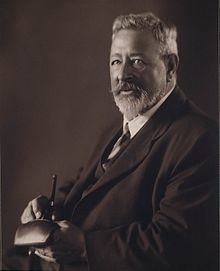Nationality Australian | Name William Dixson | |
 | ||
Born 18 April 1870 ( 1870-04-18 ) Sydney, New South Wales, Australia Occupation Businessman, collector, benefactor Died 1952, Chatswood, Sydney, Australia | ||
Sir William Dixson (18 April 1870 – 17 August 1952) was an Australian businessman, collector and benefactor who bequeathed his collection of over 20,000 items of Australiana to the State Library of New South Wales, forming the Dixson Library. In recognition of his public benefactions, Dixson was knighted in the New Year Honours of 1939.
Contents
Life and education
Dixson was the eldest surviving son of tobacco manufacturer and philanthropist Sir Hugh Dixson. He was educated at All Saints' College in Bathurst, New South Wales and gained engineering qualifications in Scotland in 1889-96. He returned to Australia and worked for several years for the engineer and urban visionary, Norman Selfe. He is the author of a small work on the French explorers Dumont D'Urville and Lapérouse.
Dixson was a director of various businesses and public bodies, including Dixson & Sons Ltd from 1899-1903; the British-Australasian Tobacco Co. Ltd from 1903–08; the City Bank of Sydney from 1909–17; the Dixson Trust Ltd from 1909–52; and Timbrol Ltd until 1952.
Australian artist Lionel Lindsay made some etchings of Dixson based on "quick sketches" by local artist Walter Syer after a visit to the Mitchell library in June 1893.
Collection
Dixson, who began collecting books and manuscripts in the 1890s, originally focussed on Australiana. However, the collection also includes many European works considered to be "rare and valuable". Together with the earlier bequest of David Scott Mitchell the printed book collections represent the published history of Australia and especially New South Wales of the time. Collection strengths include the exploration of the Pacific, Antarctica and Australia. Also included are significant collections relating to Australian literature, theatre, art, architecture, sport, natural history, Indigenous material and biography.
"Dixson's collecting soon widened to include many formats – not only books and manuscripts but pictures, coins, medals, curios, relics, postage stamps, bookplates and maps." He especially valued works in pristine condition and would rebind volumes showing signs of wear. At first the collection was for his own use but "...when he learned that the income from David Scott Mitchell's bequest to the Public Library of New South Wales could not be spent on pictures, he 'decided to give special attention to them'".
Among the rare and interesting manuscripts in the Dixson collection are soldiers' diaries from the First Fleet, and the invitation cards and menus from the opening in 1898 of Sydney's Queen Victoria Market Building (now known as the Queen Victoria Building) are also part of the collection.
Dixson's map collection, which became part of the 1952 bequest, "includes examples from the 16th through to the 20th century including hand coloured maps by Dutch mapmakers, Ortelius, Blaeu, de Wit, and Janssonius. Many of the maps are rare manuscript copies by inland explorers including Sir Thomas Mitchell, Ludwig Leichhardt and Augustus Gregory." There is a manuscript map by Evert Gijsbertsz on Africa, Asia and the East Indies, dated 1599. The map collection reveals the interest that Dixson took in exploration, especially "early navigation, geography and the European exploration and settlement of the Pacific".
Bequests
In 1919, Dixson offered a collection of pictures to the Library on the condition that a suitable gallery was built to accommodate them. Amongst the pictures offered as donations were a portrait of Viscount Sydney by Gilbert Stuart and several portraits of Governor Phillip and Governor Macquarie.
Opening the William Dixson gallery on 21 October 1929, the then Governor, Admiral Sir Dudley de Chair said: "It is a fine thing that Mr. Dixson has done, and his deeds are enhanced by his modest speech ... [he] has bought pictures because of their historical and topographical interest, and among them are pictures that would grace any art gallery in the world."
When Dixson's collection, that included some pictures by artists who accompanied James Cook on his exploratory voyages and eight of the Pedro de Queirós memorials, was transferred to the State Library after his death in 1952, it formed the Dixson library in the State Library of New South Wales. The Chaucer windows, bronze entrance doors and Shakespeare Library chandelier were also part of the bequest. The bequest also included £15,000, the income of which is used to buy historical pictures.
He also provided funds to establish the Sir William Dixson Foundation, which aimed to make rare materials on Australia and the Pacific available to students, through the production of facsimiles.
The main library of the University of New England in Armidale, New South Wales was established with his gift of ₤5,000 and is named in his honour.
